An excerpt from Graeme and Sue’s November 2022 South American Adventure.
This part of the trip is centred around the Napo wildlife centre in the Amazon Basin (but still in Ecuador). Ecuador is dived simply into three regions: the Andean region where Quito is, the coastal region where the port of Guayaquil is, and the Amazon Basin where Napo is. The main indigenous group is the Kichwa people (from the Anangu region), who decided that the future lay in developing an eco-tourism revenue stream. This would help fund education and better infrastructure for the scattered Kichwa groups in the Amazon Basin. 30 years ago they began developing the ecolodge we will stay at for three nights, on the banks of the Anangu Lake.
Arrival Day
To get there, we flew (with 150 others) for 25 exhilarating minutes over the Andes to Coca, the main ‘city’ of 45,000 people in the Amazon Basin. There we met Delpine, our Kiwcha-born, Quito then Minnesota-educated, polished English-speaking expert on all forms of wildlife and vegetation of the region. As he said this evening over dinner, “I grew up surrounded by all the wildlife you will see and ask questions about”. As we drove through Coca, he explained that 85% of Ecuador’s economy is based around oil discovered in … the Amazon Basin, and Coca has grown in size to house the thousands of support people in that industry. He suggested that as we went down river we would pass huge barges with trucks and heavy equipment being moved up and down from the oilfields … and we did … it did seem out of place, a little incongruous with us heading off to an ecolodge.
After filling out the disclaimer forms, we sped off very quickly in a covered long boat, down the coca river, and into the main channel of the Napo river. Apparently, of the 1000 tributaries flowing into the Amazon river itself, the Napo river is the 13th biggest. 70 km later we pulled onto a sandbank, clambered out and walked to a lovely thatch-covered meeting area on the banks of the Anangu river.
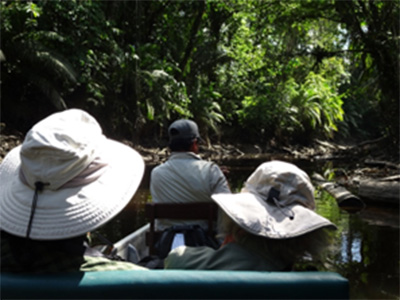
The Anangu River is the outlet for the medium-small lake where the lodge is situated, and is frequently flooded by the passing Napo river as it rises. It would be fair to say that 3-4 metres from each bank is littered with uprooted trees, with the branches conveniently chainsawed off and piled up. This left a winding centre channel of only about 3 metres in places with submerged trees only 50cm below the canoe. Our guide, Delphine, and his side-kick, George, at the rear paddled and steered brilliantly for 2 ½ hours upstream to the Ananga lake and the Napo Wildlife Centre (the correct name for the lodge. Apart from the chainsawed branches, it all was very natural, with several close sightings of spider and capuchin monkey families having a great time chasing each other and showing off their acrobatic and jumping skills. Often you would lose sight of one of them amongst the foliage only to see this shape drop 10 metres and land on the outer leafy branches of a tree below. The birds that were easiest to see close up were the ancient and odd-looking, Hoatzins.
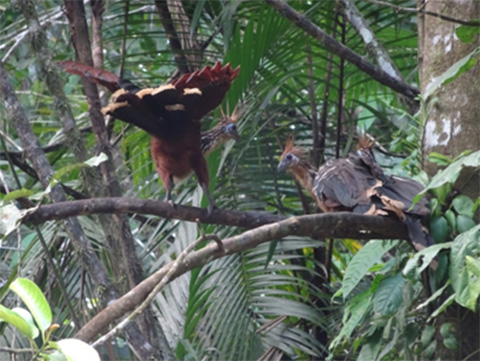
We were very excited the first time, but gradually realised more and more, that despite being incredibly unusual big pheasant-sized, colourful, noisy birds, they were not the rarity we first thought. I fact, not long after we were shown to our room, one came and visited Sue on the balcony. Other birds commonly seen were yellow flycatchers feeding on the millions of quite large river-flies we saw everywhere, and a few scarlet macaws.
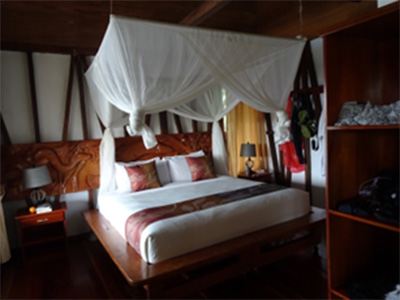
The rooms are well set out, spacious and there is a jacuzzi on the rear balcony. Dinner was a western-stye BBQ, with a few Amazonian vegetables. It does appear already (having had only one meal) that too much attention is being paid to catering for western tastes. In my humble opinion, when in Rome …. Our amazon trip in Brasil (10 years ago now!!) was special in that for every meal including breakfast, ate vegetables, fruit, fish that we had never heard of let alone tasted … sort of feel that is the way it should be here as well.
On the way down the Napo river we received a magnificent complimentary aluminium water bottle + ‘dry bag’, full of our packed lunch items. Amongst the bread roll, potato chips etc, was something that looked like an orange but was hard and sounded hollow when tapped. I carefully chipped away the coating to find pulp beneath … I removed the pulp careful to expose grey flesh with seeds … an Amazonian passionfruit. Fantastic taste and a great challenge. The only local vegetable we had for dinner was manioc or yucca (a type of potato). Probably not an appropriate time to mention, but for the record we are back to no toilet paper down the loo, instead … folded into a parcel and popped into the waste basket nearby.
First day of wildlife activities
After a restless night in the heat (25 degrees mostly overnight), and not used to the fan, the endless cicadas, frogs and unidentified sounds in the lake immediately outside, we got up at 5:10am, had a quick bit to eat for breakfast at 5:30 and were in the canoes at 6am on the dot. We are part of a group of 6 including Delpine our English-speaking guide, George our Kichwa bush expert supplementing Delpine, and a Massachusetts retired couple, Gary and Paulette. Gary is a big photographer of any wildlife, has all the gear and with Paulette has traveled the world seeking natural places to observe wildlife. The lake was gorgeous at 6am. The sun was just rising, the light remarkable and not a breath of wind. Only about 20 degrees, but you could sense it warming up quickly.
On the other side of the lake we walked along a forest track to a 35 metre observation tower. On the way, stopped to observe and photograph woolly monkeys (quite rare) and a bit further on the unmistakable howler monkeys. They had begun their very loud territorial ‘growling’ (supposed to be the loudest mammal) at 4:30am, but across the lake we thought it was the wind whistling through the trees.
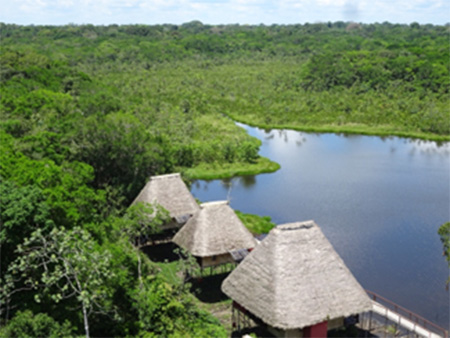
I won’t bore you with the bird species seen along the way because the piece de resistance was the bird watching on top of the tower. At the very top the tower platform rests on a very broad horizontal branch of a giant kapok tree, one of the few tallest emergent trees in the Amazonian rain forest, sitting above the main canopy. In fact, from the top, you could literally spot all the mature kapok trees protruding. The observation tower is nothing without bird experts. George had his traditional Kichwa iPhone with the recorded calls of perhaps 30 species of birds. A few minutes after playing a particular bird song, the birds would respond from about 1 km away and fly closer. Delphine had his bird watching telescope, so …. using binoculars, he spotted the birds, and we could then observe them with his telescope, locate them, and then use our own binoculars to watch for about 5 minutes. The birds invariably moved off, and George would summon more species. Notable were three species of toucan, tanagers, scarlet macaws and blue macaws, kites, vultures and so on.
I am not so quick at finding things with powerful binoculars, and even less good at using my little Sony camera on 30x optical zoom to then locate, focus and take photos. I got some good ones, and had lots of almosts. We were visited by a rough tailed male iguana, who posed on a nearby (0.5m) branch of the kapok tree we were in. He was displaying to attract a female, but all he got was us photographing him.
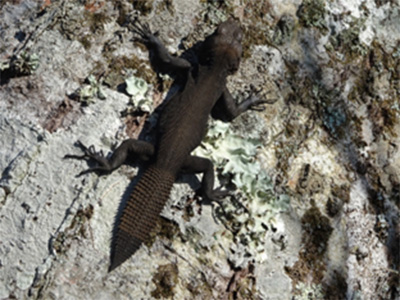
A beautiful day, but as it got hotter and hotter, we got more troubled by insects, Sue identified a wasp nest in our tree branches that looked like crumpled paper, but what we didn’t know was that the reddish wasps like sitting on the wooden rail in the heat. She put her hand on one and got stung in the finger tip for her troubles. Delphine didn’t seem perturbed … “will hurt for one hour only”. In the meantime, although I sympathised with Sue, I was itching all over hands, arms and back. I must be really sensitive to small bites and it drove me nuts for the next couple of hours till we got back across the lake. Ants trapped in my clothes, apparently. Hang them up at night.
The walk back to the canoe was a mixture of techniques that the Kichwa traditionally use for extracting fibres from only one species of palm frond, dyes from a different species, the ‘stilt’ supporting root systems of the ironwood palm compared to the giant flared buttresses of the kapok trees, and various tests (which we all failed) to find the camouflaged insects and frogs, amongst dried leaves. David Attenborough would have been very excited. Three species of large tree, flower and fruit on their main trunks, from ground level up to 10 metres or so … very convenient for the local people. Not sure what animal spreads the seeds though.
Lunch is completely over the top. Expecting a light buffet-style lunch of salads and fruit, we were surprised to be served soup, filet mignon (!) and vegies followed by desert. The soup was spicy prawn Asian style and was excellent. I was just about to say “that will be plenty, thanks”, when our plates of main course arrived. I don’t know what happens to the ½ serving of filet mignon left on the plate, but I did get to cancel desert. Somewhere along the way, it would appear that the surveys have revealed western food, and lots of it, is best … pity. Just outside the dining room lounge was a viewing area, and despite having watched capuchin monkeys before, they always amuse. One in particular had found a banana palm, and dexterously peeled two ripe bananas and scoffed the lot in under a minute. Very cool to watch and photograph from 5m away.
In the heat of the early afternoon we simply rested, to reconvene in the canoe at 3:30pm for a leisurely paddle to see the huge numbers of shore birds and colourful nesting birds around the edge of the lake. First, however, our guide noticed the head of what turned out to be a VERY large 3.5m caiman. We obviously paddled over to how close we could get. HUGE! Even in this smallish lake two inhabitants grow to a huge size: the caimans and the giant freshwater fish, Aparaima (Piraracu which grow to 9 feet, and weigh over 200 kg!). The noises, like waves crashing, we heard last night were either of the above, making life miserable for something smaller than them.
What sounds like a pretty tame afternoon paddle, bird-watching, was in fact, a great activity. Very warm, balmy, sun starting to create beautiful light on the trees and grasses, and full of surprises.
We loved watching the weaver birds. There are hundreds of species from South America to Africa, and perhaps 30 mating pairs build their uniquely shaped hanging basket nests in the same tree. What we didn’t know was that round the lake two species use the same tree, with the larger almost magpie sized bright yellow and black species taking the penthouse suites at the top of the top, leaving the slightly smaller species to the lower branches. The bully-boys built intricately woven 0.5 metre long, narrow neck vase-like nests, while the subjugated species prefer the open weave, messy looking, rounder nests with a stupidly large entrance, that any predator could enter.
Probably another 15 species of other colourful birds made their appearance briefly, before we got the call from another canoe that they had spotted a three-toed sloth nearby. This involved a bayou-type journey up a narrow ‘creek’, 10 minutes of watching it gradually acknowledge our presence, and turn slowly to face us (hanging upside down 15 m up a tree). Fantastic. That was when our canoe cohabiter photographer said “it was almost as good as seeing a black-maned tamarin monkey at lunchtime”. I have always wanted to see a tamarin …. A bit jealous …
Having been offered a large lunch menu, dinner was even more food. Western style again, with pork chops as a main. I had the soup, called the waiter over and asked for just veggies, no pork chops. He nodded, and brought me specially prepared (for the possible Islamic tourist) fish fillets.
A very good day in a wonderful place.
To be continued…